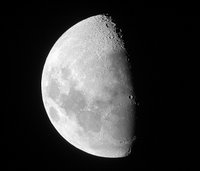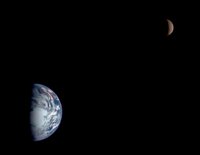 What goes around
What goes aroundLook at the moon. I mean really look at the moon. Crane your neck and regard the earth's traveling companion. Try it. Were you stunned by what you saw?
You should be. Unfortunately, the moon is to most of us just an everyday object that recedes into the background. That describes my usual reaction to the moon, too. However, I am a child of the Space Age who was a teenager at the time of the first moon landing. When I dig back into my memories, I recall how it seemed at the time. On occasion, I can still recapture some of those sensations.
It happened again recently. The moon helped. I was out for a late afternoon stroll and a dab of white in the sky caught my eye. The timing was perfect. The sky was blue and clear; the waxing moon was slightly past half full. And it was round. The moon does not always strike the eye as a round object, but a couple of days before or after the half moon is the perfect time to capture the moon's three-dimensionality. The terminator—the line separating the lit side of the moon from the dark—is gently bowed at those times, turning the moon's visual aspect into a ball. Half moon is no good. The terminator is a straight line right down the middle and all you see is a half-disk in the sky. If anything, the full moon is worse. The washed-out satellite turns into a tarnished silver disk mounted on a sable background. The full moon has no more depth or mystery than an Elvis on velvet.
I, on the other hand, looked up at the moon at the perfect moment and saw a huge round rock hanging in the sky. When this perspective seizes your senses, you are suddenly on the greatest thrill ride in the world. There is a huge rock hanging in the sky! And the earth beneath you also becomes an orb, a sphere on which you are standing. Try not to get too dizzy. There is no better moment at which to capture the sensation of living in a planetary system than when you look at the partially lit moon with the understanding that you are standing on a similarly lit sphere.
After some seconds—maybe a couple of minutes if you're lucky—you come back to earth and the moon is just the moon again. Some little-regarded reflector of the sun's glory. But you'll remember that you had the sensation, even if the sensation itself is gone. And one day it will all strike you again.
 You are here
You are hereI am not a traveler. While I don't mind seeing new places, I find the process of getting there too onerous to endure cheerfully. Airports and security screenings particularly put me off. Any trip that takes me too far away to end up spending the night in my own bed is normally too long a trip as far as I'm concerned. I know that most people are not homebodies to the degree I am, but that's the situation.
Nevertheless, I have been overseas. Once. I travel a few hundred miles every couple of months to visit family (both of my parents are alive and in good health). And recently I was talked into going to a conference for math teachers in southern California. It was sponsored by my publisher and I resolved that it would be a good thing to do. It was. I met some excellent math professors from several western states, had great discussions with them, and enjoyed the off-season resort locale.
I also noticed something I had forgotten about previous trips: Travel really is distracting. Problems that previously obsessed you seem to recede into the background and you end up regarding them from a new perspective. Perhaps you even discover that what you thought was serious is rather trivial. Breaking out of a routine can shake things up and recharge your batteries. I guess that's what people mean when they talk about vacations and recreation. I'll have to remember that.
I am, of course, constructing a parallel here. You don't actually go anywhere when you look at the moon. (Remember, I mean look at the moon.) But it can give you a tiny bit of perspective that reveals the scale at which we live. Whether that pleases or daunts you is an individual reaction.
My nephew and I were discussing the moon the other day. He informed me that you have to wait till night to see the moon. He's six, so he's not to be judged too harshly for his observational lapses. Many adults probably think the same thing. The moon is merely more obvious during the night, but it spends as much time above the horizon in daylight as it does in night-time. It's always there, visible more often than not, ticking away the clockwork of the spinning system in which we reside.
It is an extraordinary occurrence for a planet to have a satellite as large as our moon. Sure, the moons of Jupiter are even larger, but they shrivel to insignificance next to the bulk of Jupiter itself. Proportionately speaking, our moon is an enormous planetary satellite. It is both large enough and close enough to be a spectacular sight in earth's sky—a spectacle to which we have become accustomed. Try, however, to look up at it with new eyes. And brace yourself.












No comments:
Post a Comment